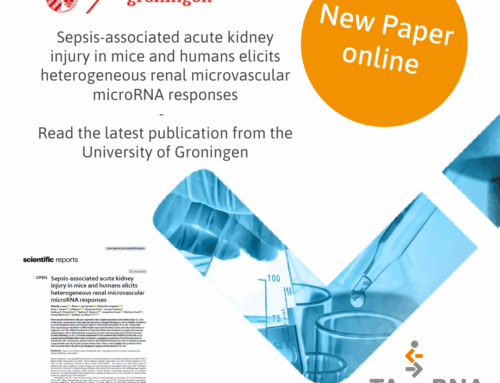On November 19th, 2025, the study “Synovial Fluid MicroRNA Biomarkers Enable Accurate Diagnosis of Hip and Knee Periprosthetic Joint Infections” by Frank et al. was published in the Journal of Bone and Joint Surgery.
This peer-reviewed publication marks an important milestone in TAmiRNA’s biomarker development program and presents promiR®, our novel microRNA-based diagnostic panel designed to improve the pre-operative assessment of periprosthetic joint infections (PJIs).
Clinical Challenge
PJIs remain one of the most serious and difficult complications following total joint replacement. Current diagnostic methods—including inflammatory markers, imaging, and cultures—often lack sensitivity and specificity, especially for low-grade or culture-negative infections. Even advanced approaches such as PCR or next-generation sequencing can suffer from contamination risks and ambiguous interpretation. As a result, diagnostic uncertainty may delay appropriate treatment, leading to unnecessary interventions or poorer outcomes.
Study Approach
To address this unmet clinical need, TAmiRNA collaborated with Dr. Bernhard Frank and Dr. Jochen Hofstätter at the Orthopaedic Hospital Speising to evaluate whether cell-free microRNAs in synovial fluid can serve as accurate biomarkers for PJIs.
- Discovery phase: Using TAmiRNA’s miND® small RNA-sequencing workflow, microRNA expression was profiled in 48 synovial fluid samples. More than 100 potential biomarker candidates were identified, from which 18 top candidates were selected based on strong enrichment in immune cell–derived populations such as neutrophils, T cells, and B cells.
- Technical validation: These candidates were then tested using TAmiRNA’s LNA-enhanced microRNA qPCR platform, achieving 100% replication of the NGS discovery results.
- Clinical validation: Independent validation in 133 synovial fluid samples confirmed excellent diagnostic performance, with median classification performances (ROC AUCs) exceeding 0.95 for multivariable models.
A two-marker model consisting of miR-338-3p (neutrophil-enriched) and miR-214-3p (an inflammation-responsive microRNA from joint tissue) achieved 95.8% sensitivity in the validation cohort—including chronic infections and culture-negative cases.
Why MicroRNAs Work So Well
The strong diagnostic performance of microRNAs is supported by biological mechanisms:
- Infection leads to infiltration and activation of neutrophils and lymphocytes, releasing microRNAs that are highly enriched in hematopoietic cells responsible for innate and adaptive immune response.
- Inflammatory signaling within the joint alters microRNA transcription in chondrocytes and synoviocytes, further distinguishing infected from non-infected states.
These combined effects provide high sensitivity, even for low-grade infections, and high specificity relative to conventional biomarkers.
Recognition of Excellence
The significance of this work is highlighted in an accompanying commentary by Elissa Rennert-May and Mansour Abolghasemian, who write:
“The authors should be applauded for presenting not only compelling data but also a rigorous, multidisciplinary framework that can serve as a template for the future development of molecular biomarkers in orthopaedics. Their integration of clinical relevance, molecular biology, and bioinformatics elevates the impact of the study and sets a high bar for translational research in this field.”
Conclusion
The publication of promiR marks a major step toward transforming the diagnostic pathway for PJIs. By combining high-quality clinical samples, state-of-the-art molecular profiling, and advanced data analytics, TAmiRNA and its collaborators are paving the way for more accurate, rapid, and reliable infection diagnostics in orthopedic care.














Leave A Comment
You must be logged in to post a comment.